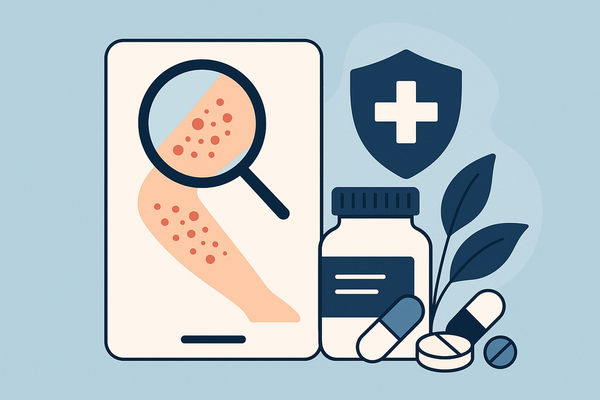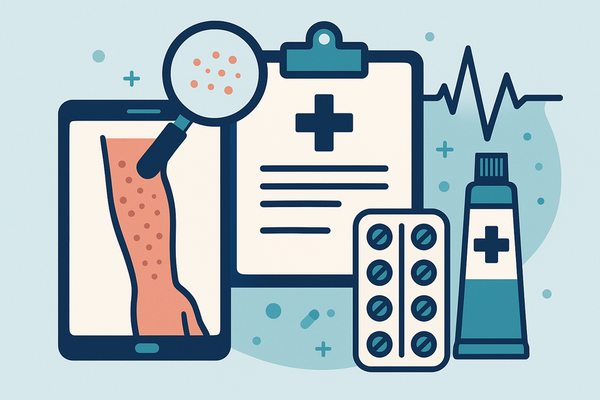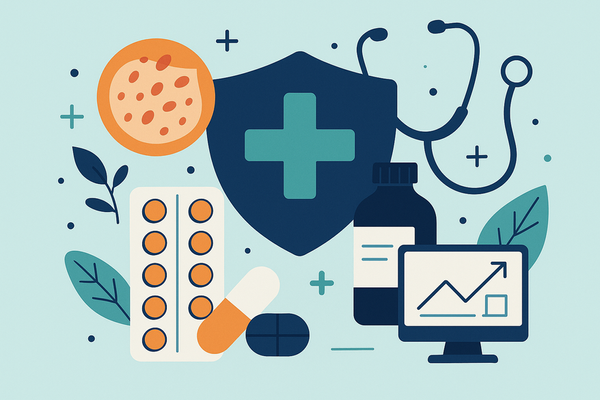How Next-Gen Dermatology Apps Are Revolutionizing Rash Detection and Skin Care
Explore how next-gen dermatology apps revolutionize rash detection with AI and telemedicine, improving accuracy, speed, and accessibility in skin care management.

Estimated reading time: 8 minutes
Key Takeaways
- Next-gen apps use AI and machine learning for rapid and accurate rash diagnosis.
- Telemedicine integration and real-time analytics bridge access gaps and speed up care.
- User-friendly interfaces and engagement tools boost patient adherence.
- Emerging technologies like AR, deep learning, and big data enhance predictive care.
- Privacy, security, and the need for human oversight remain critical considerations.
- Future outlook points to personalized and preventive dermatology via multi-modal data.
Table of Contents
- Section 1: The Evolution of Next-Gen Dermatology Apps
- Section 2: Core Features of Next-Gen Dermatology Apps
- Section 3: Impact on Rash Detection and Skin Care
- Section 4: Emerging Technologies in Next-Gen Dermatology Apps
- Section 5: Challenges and Considerations for Next-Gen Dermatology Apps
- Section 6: Future Outlook: Personalized Dermatology with Next-Gen Apps
- Conclusion
- FAQ
Section 1: The Evolution of Next-Gen Dermatology Apps
Before digital tools, dermatology required in-person visits, clinical exams, and often involved long wait times and specialist shortages. Patients in rural or underserved areas faced significant barriers to expert care.
Early digital health tools offered basic symptom trackers and static photo uploads. Users logged itchiness or redness, snapped pictures, and emailed them to clinics, resulting in slow and generic feedback.
With the rise of telemedicine, apps added secure messaging and video chats. Patients could schedule virtual visits, share images live, and receive feedback within 24–48 hours. This hybrid model sped up care but still depended on manual doctor reviews.
Now, next-gen dermatology apps mark the latest phase:
- AI-driven diagnostics analyze skin images in seconds.
- Real-time analytics compare your rash to millions of cases.
- Personalized care plans adapt to your history and lifestyle.
These technologies bridge gaps in access, speed, and accuracy, reducing in-person visits for minor conditions while flagging urgent cases for fast referrals. For example, services like AI-based photo rash diagnosis tools compare top platforms to help you choose the right solution. By combining AI, machine vision, and secure telehealth, next-gen dermatology apps deliver faster detection, better monitoring, and tailored treatments—all from your smartphone.
Section 2: Core Features of Next-Gen Dermatology Apps
AI & Machine Learning Diagnostics
- Definition: AI and ML algorithms trained on thousands of skin images spot patterns using convolutional neural networks (CNNs).
- Continuous learning: User uploads refine model accuracy over time.
- Role in rash detection: Instant image analysis flags dermatitis, eczema, and urticaria with high precision.
For a deeper dive, see our guide on machine learning in skin analysis.
Telemedicine Integration & Real-Time Data Analysis
- Secure connections: HIPAA/GDPR-compliant video calls, encrypted chat, and photo uploads.
- Fast feedback: Turn-around times under 24 hours, often within two hours.
- In-app triage: AI prioritizes urgent cases and routes lower-risk ones to routine follow-up.
User-Friendly Interface & Patient-Driven Design
- Simple navigation: Clear menus, guided photo capture, and step-by-step symptom logging.
- Engagement tools: Push reminders, medication tracking, and in-app learning modules on skin health.
- Accessibility: Multi-language support, adjustable font sizes, and voice prompts for visually impaired users.
Key Benefits:
- Rapid image analysis speeds up diagnosis and treatment.
- Secure telehealth protects privacy and meets medical standards.
- Intuitive UX/UI boosts patient engagement and adherence.
Section 3: Impact on Rash Detection and Skin Care
Accuracy & Speed Improvements
• AI accuracy: Up to 90%+ for common rashes versus a 70–80% human baseline.
• Faster diagnostics: Most users receive a preliminary result in under two hours compared to days or weeks for traditional referrals.
Real-World Examples / Case Studies
• FirstDerm: Reduced in-person referrals by 30% by letting AI triage mild cases.
• DermatologistOnCall: Average response time under two hours; 85% patient satisfaction rating.
Patient Benefits
• 24/7 app access bridges gaps in rural and underserved areas.
• No travel or long waiting rooms; consult from home or work.
• Self-monitoring tools help users track flare-ups and learn skin-friendly habits.
Provider Benefits
• AI flags high-risk lesions for urgent review, reducing caseload stress.
• AI-backed second opinions improve confidence and reduce misdiagnoses.
• Sync with EHRs and generate automated reports, saving administrative hours.
Section 4: Emerging Technologies in Next-Gen Dermatology Apps
Deep Learning & Advanced Image Analysis
- Deep learning uses multi-layer neural networks to mimic human vision.
- Image pre-processing: normalization, segmentation, and feature extraction isolate rash areas and textures.
Learn more about deep learning for skin conditions.
Big Data & Predictive Analytics
- Aggregates anonymized patient images, demographics, and treatment outcomes.
- Predictive algorithms score risk for chronic skin conditions, enabling early intervention.
Augmented Reality (AR) for Education & Diagnosis
- AR overlays virtual elements on camera feeds, guiding lesion self-exams.
- Use cases: visualize how creams spread on skin or compare current rash to past photos.
Future Integrations
- Wearables & IoT: smart patches measure UV exposure and skin hydration in real time.
- Voice assistants: hands-free symptom logging and reminders via Alexa or Google Assistant.
Section 5: Challenges and Considerations for Next-Gen Dermatology Apps
Privacy & Data Security
• Risks: data breaches, unauthorized PHI access, and identity theft.
• Safeguards: end-to-end encryption, two-factor authentication, and strict HIPAA/GDPR compliance.
Limitations of Technology
• False positives/negatives: poor image quality or unusual cases can mislead AI.
• Need for human oversight: apps should flag red-flag alerts for in-person exams to catch missed conditions.
Strategies for Mitigation
• Continuous algorithm refinement with diverse skin tone and age data.
• Transparent in-app disclaimers clarifying diagnostic limitations.
• Hybrid care models combining app assessments with scheduled clinical follow-ups.
Section 6: Future Outlook: Personalized Dermatology with Next-Gen Apps
Predictions for Evolution
• Enhanced AI: multi-modal analysis merging images, genomics, and patient history for ultra-precise diagnostics.
• Personalized medicine: tailored treatment plans based on genetic profiles and lifestyle data.
• Preventative care: predictive alerts for flares driven by environment, stress, or diet.
Emerging Use Cases
• EHR integration: seamless provider collaboration with shared patient records and treatment notes.
• Virtual Reality counseling modules: immersive education for chronic conditions like psoriasis.
Call-to-Action
• Subscribe for updates on the latest dermatology tech breakthroughs.
• Try a vetted next-gen dermatology app and share your feedback to help refine AI models.
Conclusion
Next-gen dermatology apps are transforming rash detection and skin care by combining AI, telemedicine, and user-centered design. From faster and more accurate diagnostics to predictive and personalized treatment plans, these platforms address access barriers and enhance outcomes. While privacy, security, and the need for human oversight remain top priorities, the integration of deep learning, AR, big data, and wearable technologies points to a future where preventive and precision dermatology is at everyone’s fingertips.
FAQ
How accurate are AI-based dermatology apps?
AI algorithms can achieve up to 90% accuracy for common rashes, compared to a 70–80% baseline for human reviews. However, complex or rare conditions still benefit from physician confirmation.
Are these apps safe and secure?
Leading platforms use end-to-end encryption, two-factor authentication, and comply with HIPAA and GDPR standards to protect patient data.
Can a dermatology app replace an in-person consultation?
While apps excel at triage and monitoring, they complement rather than replace in-person exams for complex or severe conditions. They flag urgent cases and guide users to appropriate care.
What should I do if the app flags a serious condition?
If an app identifies a high-risk lesion or alerts you to an unusual pattern, schedule an in-person appointment with a dermatologist immediately.
How do I choose the right dermatology app?
Look for platforms with proven clinical validation, clear privacy policies, and user reviews. Comparing features on sites like AI-based photo rash diagnosis tools can help you make an informed choice.





